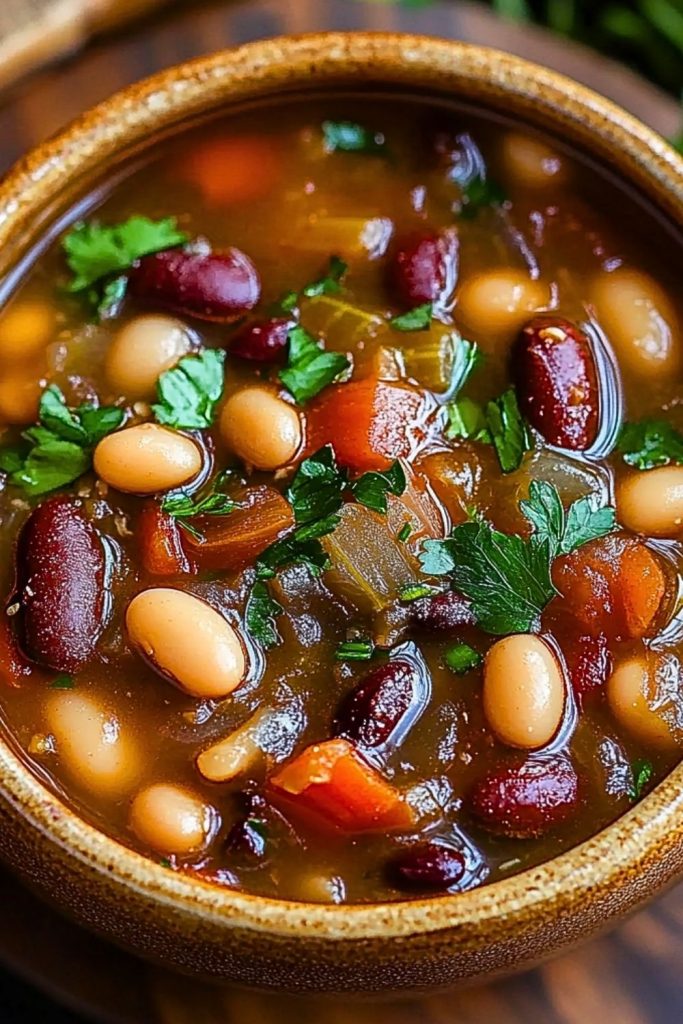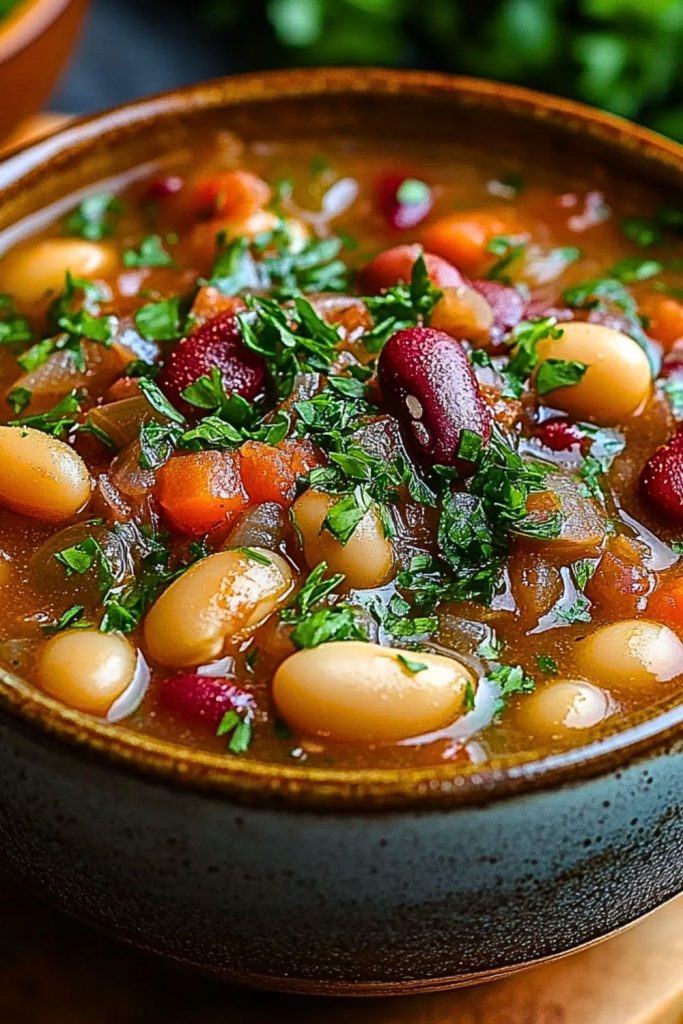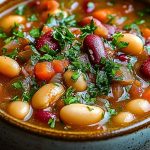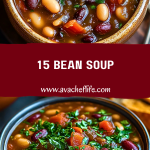When I first discovered the joy of making 15 Bean Soup from scratch, it completely changed the way I viewed comfort food. This soup isn’t just about tossing a bunch of beans into a pot—it’s a heartwarming experience packed with texture, earthy flavors, and that rustic aroma that fills your kitchen and wraps around your senses like a cozy blanket. Each spoonful delivers a medley of soft beans, savory spices, and vibrant herbs that come together into something far greater than the sum of its parts.

What I love most about this soup is how forgiving and customizable it is. Whether you’re looking to use up pantry staples, feed a crowd, or prep ahead for a week of nourishing lunches, this dish has your back. Plus, it’s naturally high in fiber and protein, budget-friendly, and incredibly satisfying. I find myself going back for seconds, then thirds—every time.
Why You’ll Love This 15 Bean Soup
- Flavorful and filling: With a mix of beans, tomatoes, and seasonings, this soup delivers big flavor with minimal fuss.
- Healthy and hearty: Loaded with fiber, plant-based protein, and nutrients, it’s a nourishing option whether you’re vegetarian or not.
- Meal prep magic: It stores beautifully, making it ideal for leftovers and busy weeknights.
- Versatile ingredients: Toss in greens, sausage, or veggies—this soup plays well with whatever you’ve got.
- One-pot wonder: Less mess, easy cleanup, and more time to enjoy that first warm bite.
What Kind of Beans Should I Use for 15 Bean Soup?
For this recipe, I always reach for a 15-bean blend, which is often sold pre-packaged in the dried bean section of most grocery stores. These blends typically include a colorful assortment like kidney beans, navy beans, pinto beans, black beans, lima beans, garbanzo beans, and more. The beauty of using a pre-made mix is not only convenience, but the balance of textures and flavors each type brings to the pot.
If you can’t find a 15-bean blend, you can absolutely make your own mix by combining smaller amounts of various dried beans. Just try to include a range of sizes and colors for the best texture and visual appeal. Avoid lentils in this mix, though—they cook faster and can get too soft compared to the sturdier beans.
Options for Substitutions
One of the reasons I keep coming back to this soup is how easily it adapts to what’s in my kitchen. Here are a few go-to swaps:
- Vegetarian/Vegan: Omit any meat and use vegetable broth for a fully plant-based version that still delivers deep flavor.
- Add Meat: Smoked sausage, diced ham, or shredded chicken all pair beautifully with the beans and help boost the savory profile.
- Tomatoes: Don’t have diced tomatoes? Use crushed or whole canned tomatoes and break them up with a spoon while cooking.
- Spice Level: Add a pinch of red pepper flakes or chopped jalapeño if you want some heat. Want it milder? Skip the spice packet (if your bean blend includes one) and season to your taste.
- Fresh Herbs vs. Dried: Both work! If you have fresh parsley or thyme on hand, stir them in at the end for a bright finish.
- Low-Sodium: Use low-sodium broth and rinse canned tomatoes to have more control over salt levels.
The key is to see this recipe as a base you can play with. It’s meant to fit into your life, not the other way around.
What Kind of Beans Should I Use for 15 Bean Soup?
The best choice is a pre-packaged 15-bean blend, which includes a variety of textures and colors like kidney, navy, pinto, black, and lima beans. It’s easy to find and delivers a well-balanced, hearty result. If you’re building your own mix, combine a diverse set of dried beans—but skip lentils since they cook too quickly and can become mushy in this slow-simmered soup.
Options for Substitutions
This soup is all about flexibility. You can go vegetarian by skipping meat and using veggie broth, or load it with flavor by adding smoked sausage or ham. Swap tomatoes for any variety you have on hand, dial up or down the spice level, and toss in fresh herbs for a final punch of brightness. Whether you’re customizing for diet, flavor, or pantry limitations, this recipe molds to your needs effortlessly.
Ingredients for This 15 Bean Soup
Let’s take a closer look at the key ingredients that make this soup so flavorful, hearty, and comforting. Each one brings something special to the bowl:
- 15-Bean Blend: The star of the dish. This colorful mix of beans gives the soup its heartiness and depth. The variety adds layers of texture—from creamy to firm—and creates a beautiful presentation.
- Onion: A must for building a savory base. Onions add natural sweetness and depth as they cook down into the broth.
- Garlic: Just a few cloves give the soup a fragrant, earthy note that lingers in the background without overpowering.
- Diced Tomatoes: These add a touch of acidity and brightness to balance the richness of the beans. They also help create a well-rounded broth.
- Carrots & Celery (Optional but Recommended): They bring color, slight sweetness, and a classic soup flavor profile. They also soften beautifully during simmering.
- Smoked Sausage or Ham (Optional): For a meaty twist, these ingredients infuse the broth with smoky, savory notes. A little goes a long way.
- Vegetable or Chicken Broth: This forms the base of the soup and infuses it with flavor as the beans simmer and soften. Choose low-sodium if you want to control the saltiness.
- Bay Leaves & Dried Herbs (like thyme, oregano, basil): They bring subtle, aromatic complexity that rounds out the dish.
- Salt & Pepper: Essential for enhancing all the other flavors—adjust to taste, especially if you’re using a spice packet or meat.
- Fresh Parsley (for garnish): A bright, fresh pop right before serving. It lifts the soup and adds visual appeal.

Step-by-Step Instructions for Making 15 Bean Soup
Making 15 Bean Soup is incredibly rewarding and surprisingly easy. Let’s walk through each step so you can simmer your way to a rich, soul-warming bowl.
Step 1: Soak the Beans (If Needed)
If you’re using a traditional dried 15-bean blend, it’s best to soak them overnight. This helps them cook more evenly and reduces cooking time. Place the beans in a large bowl, cover with water by a couple of inches, and let them sit overnight. Drain and rinse before using.
Shortcut: If you’re short on time, use the quick soak method—boil the beans for 5 minutes, turn off the heat, cover, and let them sit for 1 hour.
Step 2: Sauté the Aromatics
In a large pot or Dutch oven, heat a drizzle of olive oil over medium heat. Add chopped onion, celery, and carrots (if using), and cook until softened—about 5–7 minutes. Add minced garlic and stir for another 30 seconds until fragrant.
Step 3: Add Beans, Tomatoes, and Broth
Stir in the soaked and drained beans, diced tomatoes (with juices), and your choice of broth (vegetable or chicken). Add bay leaves and dried herbs like thyme or oregano. Bring everything to a boil.
Step 4: Simmer Low and Slow
Reduce heat to a gentle simmer. Cover the pot slightly ajar and cook for 1.5 to 2 hours, stirring occasionally. The beans should become tender and the broth thickens beautifully as the starches release. If it gets too thick, add a splash of water or broth to loosen it up.
Step 5: Add Meat (If Using)
About 30 minutes before the soup is done, stir in chopped smoked sausage, ham, or shredded chicken if you’re including meat. Let it heat through and infuse the broth with savory depth.
Step 6: Final Seasoning
Once the beans are fully tender, taste the soup. Season with salt and freshly cracked black pepper. You can also stir in a squeeze of lemon juice or a splash of vinegar to brighten the flavors.
Step 7: Garnish and Serve
Ladle the soup into bowls and garnish with chopped fresh parsley or a sprinkle of red pepper flakes if you like a bit of heat. Serve warm with crusty bread or cornbread.
How Long to Cook the 15 Bean Soup
Cooking time depends on whether or not you soaked the beans, and whether you’re using a stovetop, slow cooker, or pressure cooker:
- Stovetop (with soaked beans): 1.5 to 2 hours of gentle simmering until the beans are soft and creamy.
- Stovetop (without soaking): Up to 2.5 hours. Just be sure to monitor the liquid level and stir occasionally to prevent sticking.
- Slow Cooker: 7–8 hours on low or 4–5 hours on high. No need to soak the beans, but be sure to use enough broth to keep them submerged.
- Pressure Cooker / Instant Pot: 35–40 minutes on high pressure with a natural release. Soaking is optional but does reduce the pressure cooking time by about 10 minutes.
The soup is ready when the beans are tender and the broth has thickened into a silky, flavorful base.
Tips for Perfect 15 Bean Soup
Here’s how to take your soup from good to unforgettable:
- Soak the beans when possible: It makes a big difference in texture and shortens the cooking time.
- Go low and slow: Simmering the soup gently helps develop deeper flavors and prevents beans from breaking apart.
- Stir occasionally: Especially if you’re cooking on the stovetop. Beans love to settle at the bottom and stick.
- Layer your seasoning: Start with herbs and aromatics, then adjust with salt, pepper, and acid (like lemon juice or vinegar) at the end.
- Add meat later: To keep smoked sausage or ham tender and flavorful, add it in the last 30 minutes of cooking.
- Keep the lid slightly ajar: This lets the soup reduce just enough without drying out.
- Use a mix of broth and water if needed: If you’re low on broth, it’s totally fine to dilute with water. Just taste and adjust the seasoning.
- Brighten it at the end: A splash of lemon juice or a few grinds of fresh pepper wakes up the entire pot.
Watch Out for These Mistakes While Cooking
Even with a forgiving recipe like 15 Bean Soup, a few common mistakes can stand in the way of that rich, satisfying bowl. Here’s what to keep an eye on:
- Skipping the soak without adjusting time: If you don’t soak your beans, you must increase the cooking time and keep an eye on liquid levels. Otherwise, you risk hard beans or burnt bottoms.
- Adding acidic ingredients too early: Tomatoes and lemon juice are delicious here—but if added before the beans are tender, they can slow down cooking dramatically. Wait until the beans are mostly cooked before adding acidic components.
- Not tasting as you go: This soup needs layering of salt and spices. Waiting until the end to season can leave the soup tasting flat.
- Overcooking meat: Adding sausage or ham too early can dry them out or make them rubbery. Add them in the final stretch of cooking for best texture and flavor.
- Forgetting to stir: Beans love to stick, especially near the end. Stir occasionally to avoid burning or uneven cooking.
- Under-seasoning broth: Beans absorb a lot of flavor. Taste and season your broth generously to ensure the final dish is deeply flavorful.
- Using old beans: Beans that have sat in your pantry too long may never fully soften. Make sure your dried beans are within their best-by date.
- Crowding the pot: Overfilling your pot with too many beans or add-ins can result in uneven cooking. Stick to recommended amounts for the best texture.
What to Serve With 15 Bean Soup?
This soup is rich and hearty on its own, but a few simple pairings can turn it into a complete, soul-satisfying meal. Here are my favorite ways to round it out:
1. Cornbread
Golden, crumbly, and just a little sweet—perfect for dunking into the soup.
2. Crusty Artisan Bread
A warm, rustic loaf with a crisp crust is ideal for soaking up all that savory broth.
3. Grilled Cheese Sandwich
The gooey, melty center adds richness, and the crisp edges contrast beautifully with the creamy soup.
4. Garlic Toast
Bold and flavorful, garlic toast brings another layer of comfort and crunch.
5. Simple Green Salad
A light, lemony salad with arugula or mixed greens balances the heartiness of the soup.
6. Pickled Vegetables
A sharp, tangy side like pickled onions or cucumbers helps cut through the richness.
7. Roasted Brussels Sprouts
Caramelized and slightly crispy, they’re a healthy and delicious match for bean soup.
8. Apple Slaw
A fresh slaw with apple and cabbage adds a sweet, crisp contrast to the warm and savory bowl.
Storage Instructions
One of the best things about 15 Bean Soup? It gets better the next day. The flavors deepen, the beans soak up more of the broth, and the texture becomes even richer. Here’s how to store it like a pro:
- Refrigerator: Let the soup cool completely, then transfer it to an airtight container. It will keep well in the fridge for up to 5 days. Reheat on the stovetop over medium heat or microwave individual servings until hot.
- Freezer: This soup freezes beautifully. Spoon cooled soup into freezer-safe containers or zip-top bags (lay them flat for easy stacking) and store for up to 3 months. Be sure to leave a bit of space at the top of the container, as the soup will expand when frozen.
- Reheating Tips: When reheating, you may notice the soup has thickened. Just stir in a splash of broth or water to loosen it back to the perfect consistency.
- Portioning: If you’re meal prepping, freeze in single-serve portions to make weekday lunches or quick dinners easy and stress-free.
Estimated Nutrition (per 1½ cup serving)
These values will vary slightly depending on the exact ingredients and whether you include meat, but here’s a general estimate for a classic vegetarian version:
- Calories: 280–320
- Protein: 17–20g
- Carbohydrates: 45–48g
- Fiber: 12–14g
- Fat: 4–6g
- Sodium: 450–600mg (depending on broth and added salt)
- Sugar: 4–6g
This soup is high in plant-based protein and fiber, low in fat, and packed with essential vitamins and minerals from the variety of beans and vegetables. It’s a filling and wholesome choice, especially for anyone looking for heart-healthy, budget-conscious meal ideas.
Frequently Asked Questions
Can I use canned beans instead of dried?
You can, but the flavor and texture won’t be quite the same. If you’re in a hurry, use about 4–5 cans of mixed beans, drained and rinsed. Reduce the cooking time significantly—just long enough for the flavors to meld, around 30 minutes.
Do I have to soak the beans?
Not necessarily. Soaking helps beans cook faster and more evenly, but it’s not required. If you skip the soak, add extra cooking time and keep more broth or water on hand to prevent drying out.
Can I make this in the Instant Pot?
Absolutely. Use the sauté function to cook your aromatics, then add the rest of the ingredients. Pressure cook on high for 35–40 minutes with a natural release. It’s a great time-saver with delicious results.
Is this soup gluten-free?
Yes, as long as your broth and any added meats (like sausage) are certified gluten-free, the rest of the ingredients are naturally gluten-free.
How do I make this soup vegetarian or vegan?
It’s simple—just skip the meat and use vegetable broth instead of chicken. You’ll still get plenty of flavor from the beans, herbs, and tomatoes.
Can I add greens to the soup?
Yes! Stir in spinach, kale, or Swiss chard during the last 10 minutes of cooking. They add a lovely freshness and boost the nutrition.
Why are my beans still hard after hours of cooking?
They may be old. Dried beans that have sat in your pantry for over a year can resist softening. Also, adding acidic ingredients (like tomatoes or vinegar) too early can slow down cooking—wait until the beans are almost tender before adding those.
What’s the best way to thicken the soup?
Let it simmer uncovered toward the end, mash a few beans against the side of the pot, or blend a small portion and stir it back in. It’ll give the soup a naturally creamy texture without needing cream.
Conclusion
15 Bean Soup is the kind of dish that feels like a hug in a bowl—nutritious, deeply satisfying, and incredibly adaptable. Whether you’re cooking it up on a rainy Sunday, freezing it for meal prep, or serving it to a crowd with warm cornbread on the side, it delivers comfort and nourishment every time.
I’ve made this soup countless times, and each pot is just a little different based on what I have on hand. That’s the magic of it: no two bowls are ever exactly the same, but they’re always delicious. If you’re looking for a simple, wholesome, and flavor-packed recipe to add to your rotation, this one’s a keeper.

15 Bean Soup
- Prep Time: 15 minutes
- Cook Time: 1 hour 30 minutes
- Total Time: 1 hour 45 minutes
- Yield: 6-8 servings
Description
This 15 Bean Soup is the ultimate cozy meal—a hearty, healthy, and flavor-packed bowl that’s easy to make and endlessly versatile. Loaded with a colorful blend of beans, tender vegetables, and rich broth, it’s the perfect quick dinner or satisfying lunch idea. Whether you’re looking for an easy recipe to meal prep, a comforting dinner idea for a cold night, or a nutritious option that’s both filling and budget-friendly, this soup checks every box. With bold flavor, creamy texture, and customizable ingredients, it’s a go-to for healthy snack or weeknight dinner cravings. One spoonful and you’ll be hooked!
Ingredients
- 1 (20 oz) package 15-bean blend
- 1 medium onion, chopped
- 2 carrots, diced (optional but recommended)
- 2 celery stalks, diced (optional)
- 3 cloves garlic, minced
- 1 (14.5 oz) can diced tomatoes, with juices
- 6 cups vegetable or chicken broth
- 1 tablespoon olive oil
- 2 bay leaves
- 1 teaspoon dried thyme
- 1 teaspoon dried oregano
- Salt and black pepper, to taste
- 1 cup chopped smoked sausage or ham (optional)
- Fresh parsley, chopped (for garnish)
- Lemon juice or red wine vinegar (optional, to finish)
Instructions
- Soak the beans overnight or use the quick soak method by boiling them for 5 minutes and letting them sit for 1 hour. Drain and rinse.
- Sauté aromatics: Heat olive oil in a large pot. Add onion, carrots, and celery. Cook until softened, about 5–7 minutes. Add garlic and stir for 30 seconds.
- Combine ingredients: Add soaked beans, diced tomatoes (with juices), broth, bay leaves, thyme, and oregano. Stir well.
- Simmer: Bring to a boil, then reduce heat. Cover partially and simmer for 1.5 to 2 hours, stirring occasionally, until beans are tender.
- Add meat (if using): Stir in chopped sausage or ham during the last 30 minutes of cooking.
- Season and finish: Add salt and pepper to taste. For brightness, stir in a splash of lemon juice or vinegar.
- Serve: Garnish with chopped parsley and enjoy warm.

